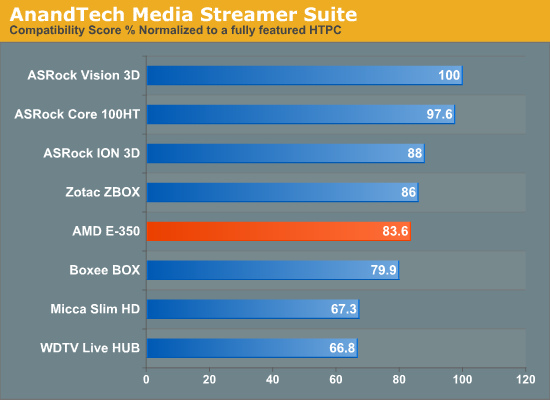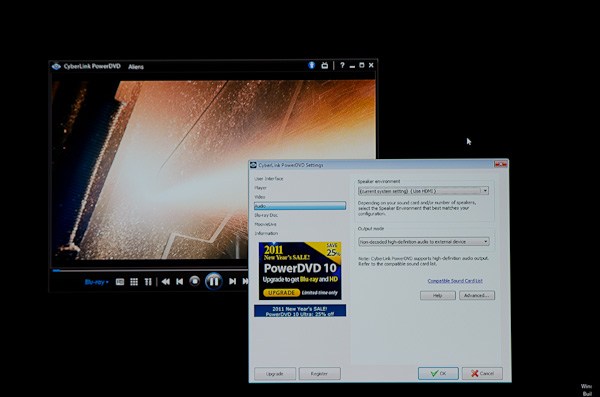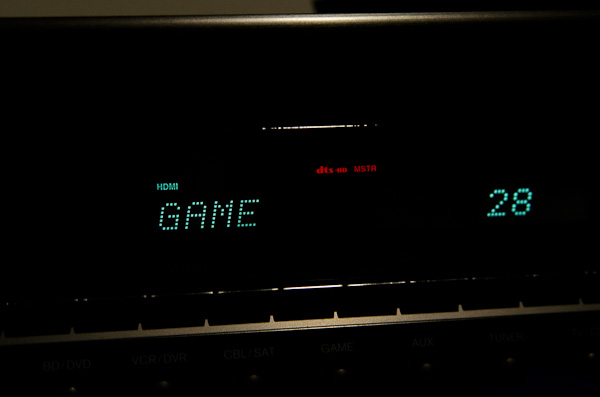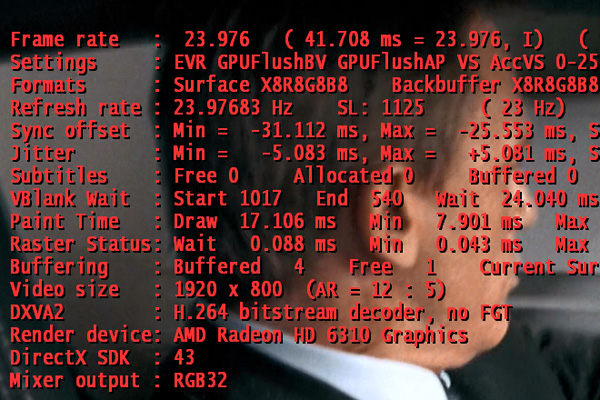The Brazos Review: AMD's E-350 Supplants ION for mini-ITX
by Anand Lal Shimpi on January 27, 2011 6:08 PM ESTVideo Decode Capabilities: Is Brazos the New ION?
While Atom may have been the right product at the right time, it was a very conservative architecture paired with a very conservative platform. For netbooks and nettops Intel chose to assume no risk at all, pairing Atom with the proven 945 chipset. As a result, it left a lot of room for innovation - something NVIDIA saw and capitalized on with ION.
While VIA created the mini-ITX form factor, it was really NVIDIA that made it interesting. The first mini-ITX ION platforms gave you almost everything you needed to build a fully capable HTPC. For video playback, with NVIDIA’s GPU (or at least its fixed function decode pipeline) doing the heavy lifting, the fact that you had an anemic Atom a couple centimeters away didn’t matter. The problem with ION is that it had no future. Without a DMI license, NVIDIA would not be able to build future versions of ION for Atom’s successors. Even after the settlement it’s unlikely we will ever see modern versions of ION, especially considering that Intel’s 2011 Atom platform (Cedar Trail) will finally integrate H.264 decode acceleration in Q4.
Where Intel is conservative, AMD will innovate. Brazos adds a number of advantages from a media standpoint over Atom. There’s native HDMI support and a full implementation of AMD’s UVD3 decode engine supporting hardware H.264, VC-1 and MPEG-2 acceleration. Although both of these advantages are also enjoyed by ION the next feature isn’t. Brazos supports Dolby TrueHD and DTS-HD MA bitstreaming over HDMI. From a feature standpoint, Brazos is even more complete than ION.
I ran MSI’s Brazos board through our Media Streaming compatibility suite. Below is Brazos’ compatibility score compared to the other devices and HTPCs we’ve put through the suite:

Failed Tests
- 1080p60 60 fps L5.1 H.264
- L5.1 H.264 (16 reference frames)
- FLAC, ASS Subs - High CPU Utilization
- HD Real Media
- Deinterlacing
Numerically, Brazos actually falls behind ION. Allow me to explain why. Our Media Streaming suite tests virtually everything you might throw at a HTPC. When it comes to the most commonly found content, Brazos excels. It can handle Blu-ray discs (although there’s no Blu-ray 3D support), it can deal with 1080p x264s commonly found online and it even accelerates Flash video (more on this later). Brazos’ UVD3 however is tied to clock speed, and the GPU clock of the Radeon HD 6310 is pretty low at 500MHz. As a result, Brazos fails certain tests. The platform is incapable of accelerating and playing back 1080p60 H.264 video. Very little content falls into this category, however if you want to play it you can’t on Brazos. The good news is 1080i60 works just fine.
Brazos’ GPU also fails all of our deinterlacing tests, something we noticed in reviews of AMD’s entry level GPUs. The higher end models don’t have an issue here but the lesser equipped models do. Again, chances are that you won’t want to watch interlaced content on your Brazos HTPC so this is likely not a big issue.
The other shortcomings are videos with components that aren’t accelerated by UVD3. For example, HD Real Video chugs on Brazos as does our heavy FLAC + ASS subs test. If you’re playing non-3D Blu-ray content or 1080p24 x264s you find on the web, Brazos will easily fit the bill. It’s the more eccentric content that you’ll run into CPU limitations with.
Since the Radeon HD 6310 is derived from AMD’s desktop GPUs we get full 23.976 fps support when you select 23Hz in AMD’s Catalyst driver:
Selecting 24Hz yields a 24.000Hz refresh rate.
As I mentioned earlier bitstreaming both TrueHD and DTS-HD MA are supported over HDMI:














176 Comments
View All Comments
rpsgc - Thursday, January 27, 2011 - link
It will run at x4 (comparable to PCI-E 1.1 x8)rpsgc - Thursday, January 27, 2011 - link
Since I can't edit my post...... look here for the performance penalty of running at x4 versus x16
http://www.techpowerup.com/reviews/AMD/HD_5870_PCI...
codedivine - Thursday, January 27, 2011 - link
Thanks!codedivine - Thursday, January 27, 2011 - link
I was wondering if it is possible to overclock this mobo+APU combo?allzhat - Thursday, March 15, 2012 - link
I use K10stat to increase the multiplier for my notebook (e350) from x16 to x18 (1800Mhz)or even x22 (2200Mhz), but I can't feel more performance for this APU but it draw more power consumption and heat of courseI suggest to use gamebooster for heavy application
PS: I'm sorry for my bad english
nitrousoxide - Thursday, January 27, 2011 - link
So an SSD really makes difference on Brazos platform? Now I can place my order :)My choice is Corsair Nova 64GB since it is the cheapest drive with the minimum accpetable space I need. Any drive cheaper than this one is not big enough and bigger ones are more expensive... Hope its low Random Read performance doesn't impact much, at least faster than an HDD!
Dark_Archonis - Friday, January 28, 2011 - link
Being cheap with SSDs? Good luck when you suffer reliability problems with your SSD.nitrousoxide - Friday, January 28, 2011 - link
Guess what? Somebody ran an durability test for an Intel X-25V, a non-stop read--write-erase cycle for 300 days and still working. Performance began to drop after 6 months, but keep in mind that this stress test is over 20 times beyond daily use. So it actually takes years to destroy an SSD, without SF controller, of course :)mariush - Sunday, January 30, 2011 - link
A sample of ONE is by no means enough. The same person could have tested a second SSD and have it die on him after a week.After all that's what MTBF is all about - the average time for a failure in a population of identical devices.
Ethaniel - Thursday, January 27, 2011 - link
Is it me or the Nano X2 just beats the crap out of both Brazos and Atom? Can we get a review of that chip, Anand?